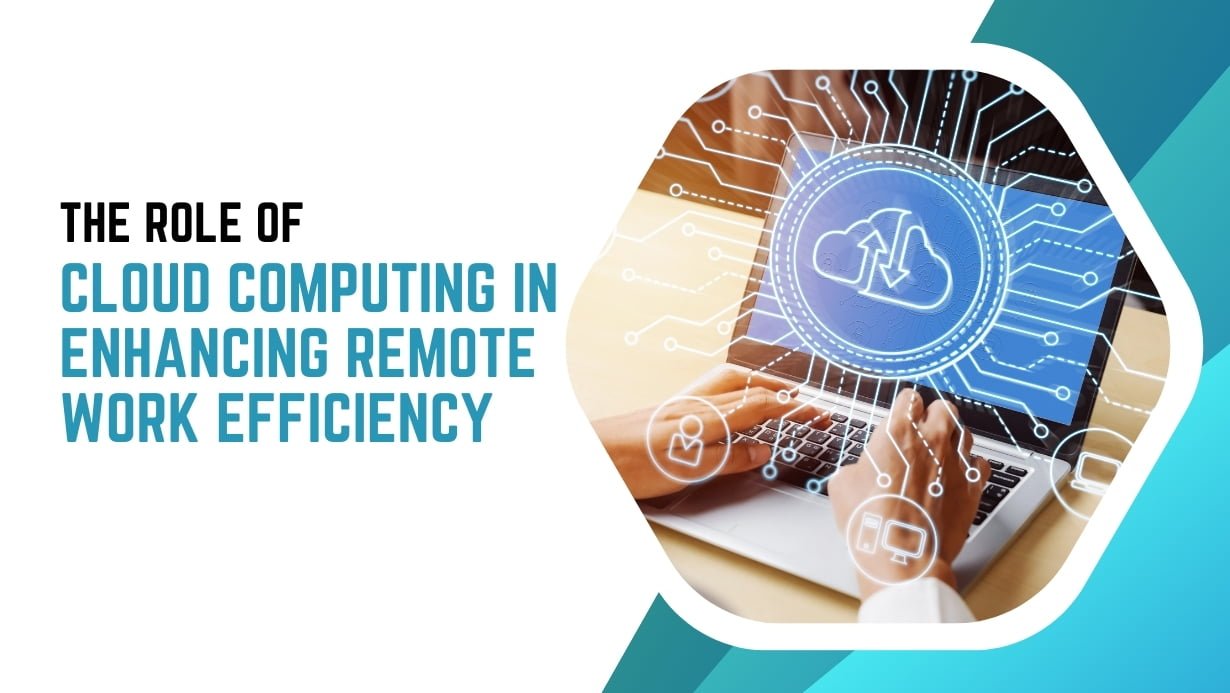One of the most profound impacts that cloud computing will have on business, especially when it comes to remote work. Cloud also will help organizations to boost productivity, simplify work processes and allow collaboration beyond physical boundaries. Part 2: Exploring The Many Ways Cloud Computing Drives Efficiency In Remote Work, Including Its Fundamental Advantages, Practical Use Cases, & Future Insights.
Introduction to Cloud Computing

Cloud computing is an IT solution that enables extensive processing power to be used via the Internet. Cloud computing utilized virtualized resources that are hosted on remote servers, as opposed to local servers and hardware. And this has played an important role in improving efficiency when it comes to working from home.
When cloud computing was new, companies used it mainly for basic tasks like data storage and email hosting. But as the technology matured, it grew in its variety of applications. At present, cloud computing caters to everything from collaborative tools and project management systems to sophisticated data analytics and machine learning.
Cloud computing is particularly appropriate for remote work due to the agility and scalability it provides. This allows organizations to create IT infrastructure quickly on-demand and avoid having to maintain any hardware. This flexibility is essential for remote teams who need consistent access to applications and data from multiple locations.
How Cloud Computing Facilitates Remote Work?
Another solution that acts as a solution for remote work is cloud computing. It does this through a handful of key features:
Centralized Data Access
Having centralized data access is one of the cloud computing benefits. This allows remote employees to access and use updated information from anywhere, which results in uniformity and lower chances of mistakes.
Real-Time Collaboration
Cloud collabration tools let teams work together in real time even not on the same spot. For example, Google Workplace and Microsoft 365 let its users work with documents at the same time, conduct virtual meetings in a secure environment, manage projects.
Scalability and Flexibility
Scalability, one of the most significant advantages of cloud computing over traditional models, provides unparalleled scalability to organizations, as they can scale up and/or down their resources based on a resource demand. What this means for remote work is that businesses can quickly accommodate variable workloads by keeping up with the influx of new users or scaling storage space.
Cost Efficiency
Cloud services enable organizations to save costs on managing physical hardware and infrastructure. Cloud providers offer a pay-as-you-go pricing model where businesses only pay for the resources they use.
Also Read: Cloud vs On-Premises: Which Solution is Right for Your Organization?
Benefits of Cloud Computing for Remote Teams
Cloud computing offers a range of advantages for remote teams, including:
Enhanced Productivity
Workflows improvement — the tools for cloud computing optimize and automate many of the monotonous tasks so that employees can devote their time to more strategic endeavors. For example, asana and Trello are project management tools that provide a framework for teams to stay organized and prioritize their tasks.
Improved Communication
Cloud-based communication platforms like Slack and Microsoft Teams are a boon for remote teams to coordinate effectively and efficiently with clear lines of communication. From instant messaging, video conferencing to file sharing, these tools facilitate a closer and more collaborative workplace.
Greater Flexibility
From laptops to tablets and smartphones, remote workers can access their work environments. This flexibility makes sure employees can work from home, co-working space or while traveling.
Enhanced Security
Although the security could pose a problem but it can be consider as better also because most of the times cloud providers have high and top level security services which is bit difficult for individual businesses to implement. Sensitive information is secured with features such as encryption, 2FA and regular security updates.
Popular Cloud Services for Remote Work
Several cloud services have become essential for remote work. Here’s a list of popular options:
| Service | Description | Key Features |
|---|---|---|
| Google Workspace | Suite of productivity tools including Gmail, Google Drive, and Google Docs | Real-time collaboration, integration with other Google services |
| Microsoft 365 | Comprehensive suite including Word, Excel, and Outlook | Robust security features, extensive collaboration tools |
| Dropbox | Cloud storage service with file synchronization | Easy file sharing, integration with third-party apps |
| Slack | Messaging platform designed for team communication | Channels, direct messaging, integrations with other tools |
| Zoom | Video conferencing tool | High-quality video calls, meeting recording, webinars |
Case Studies: Cloud Computing in Action
Many organizations have adopted cloud to facilitate their remote work. A couple of well-known examples are:
A: Tech Innovators Inc.
Tech Innovators Inc., a large-scale software development company, moved to a cloud-based infrastructure for its expanding remote team. The company adopted AWS and Microsoft Azure for development cycle efficiency and lowering infrastructure costs. This integration facilitated better collaboration among distributed teams and claimed seamless integration of development tools.
Company B: Marketing Masters, LLC.
Marketing Masters LLC, a digital marketing agency, transformed its project management and client communication with Google Workspace. Collaborative tools: […] it was, however, overdue as shared documents with real-time updates documenting progress in cloud-based project management tools enabled the team to release more accurate projects faster.
Company C: FinSecure Ltd.
FinSecure Ltd, a financial services provider, used cloud-based security solutions to facilitate the management of its data protection process. Together with cloud-based encryption and multi-factor authentication, the company completely enhanced its security posture while providing secure access to remote employees accessing sensitive data.
Also Read: Exploring Different Cloud Service Models: IaaS, PaaS, and SaaS Explained
Security Considerations for Cloud-Based Remote Work
Despite its myriad of benefits, cloud computing has brought some new security challenges. Security aspects to be addressed are,
Data Encryption
Encryption of data is an important factor to keep sensitive information secure. Avoid allowing unauthorized access to data, make sure it is encrypted while in transit and at rest
Access Control
Incorporate multi-factor authentication and role-based access control to ensure that only permitted personnel have access to particular resources.
Regular Audits
Regularly perform security audits to recognize and remediate potential vulnerabilities. Maintaining a secure cloud environment requires you to stay updated with the best practices and security updates.
Backup and Recovery
Your cloud provider should have comprehensive backup and recovery solutions. Periodic testing of the backup process to ensure data recovery within a short time frame if a failure occurs.
Challenges and Solutions in Cloud-Based Remote Work
Organizations may face the following challenges, though advantageous benefits exist in cloud computing:
Connectivity Issues
The dependence of remote work on internet connection To overcome any restrictive influence of connectivity issues, organizations simply need to plough a reliable solution and consider utilizing some form of backup internet as well.
Data Privacy
Where your data is on the cloud based then Privacy issue raise. Ensure compliance with regulatory requirements related to data protection and opt for cloud providers that adhere to stringent privacy standards.
Working with Legacy Systems
It is difficult to combine cloud solutions with already existing legacy systems. Adopt a phased approach for your migration and take professional guidance to guarantee a seamless transition.
The Future of Cloud Computing in Remote Work
Trends in the Future of Cloud Computing in Remote Work Itself although the future is bright in looks.
Increased AI Integration
Expect to see more artificial intelligence (AI) integrated into cloud computing. Artificial intelligence (AI) will drive automation, deeper insights and better decision-making for distributed teams.
Enhanced Collaboration Tools
Cloud-based collaboration tools in the future will probably allow for even greater functionality, including virtual reality (VR) meeting spaces and dynamic project planning.
Greater Emphasis on Security
In line with the changing cyber-attack threats, Cloud service providers will be working on more security development and provide an edge over robust threat detection and prevention.
Also Read: How to Optimize Cloud Costs: Tips for Budget-Friendly Cloud Management
Practical Tips for Implementing Cloud Solutions
Here are some tips to help you successfully implement cloud solutions in your remote work environment:
Evaluate Your Needs
Check what exactly your organization needs before you head towards a cloud service provider. Then you ought to look for the scalability and security parameters as well as their integration ability.
Train Your Team
Ensure your team is trained on how to use cloud tools since not all of them are intuitively usable. This would ensure optimum productivity while eliminating errors.
Monitor Performance
Make it a point to regularly check the performance of your cloud solutions against your expectations. Refine to accommodate any issues or requirements changes.
Plan for Scalability
Opt for cloud solutions that provide the ability to scale in order to prepare for future expansion. This will spare you the trouble of having to make large-scale adjustments as your organization matures.
Conclusion
Cloud computing has facilitated modern remote working and provided plenty of benefits such as greater efficiency, collaboration, and flexibility. Implementing cloud-based solutions especially could help organizations in reducing the friction between operations, enhancing communication, and eventually paving way to a more sustainable work environment for their remote teams. Cloud computing will remain a crucial part of the future of work as technology continues to evolve.
FAQ
What is cloud computing, and how does it support remote work?
Cloud computing is a virtualized computing resource that is provided over the internet. Thus, it gives remote workers access to your data, applications, and tools to collaborate from anywhere in the world.
What are some of the key advantages associated with cloud computing for remote teams?
Some of the key benefits include access to centralized data, real-time collaboration, scalability, cost efficiency, and security enhancement, Some of the most popular services include Google Workspace, Microsoft 365, Dropbox, Slack, and Zoom.
How do organizations overcome concerns related to security over cloud computing?
However, they must have encryption over data, strong access control, regular security audits, and reliable backup and recovery measures over their organizations.
Which are the trends that you see emerging in cloud computing for remote work in the future?
Some of them include more AI-based tools, better collaboration software, and much ado about security.

